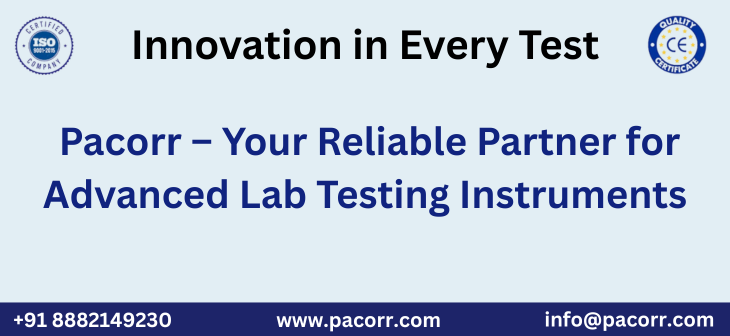
Pacorr is a trusted name in the world of advanced testing instruments, and one of its most robust solutions for simulating transportation stress on packaging is the Vibration Table. This machine plays a critical role in testing the durability, integrity, and safety of various packaging materials and products before they are shipped to market. Whether you are manufacturing corrugated boxes, plastic containers, electrical appliances, or fragile consumer goods, the Vibration Table ensures your products can withstand vibrations during transit.
This blog will give you an in-depth understanding of what a Vibration Table is, how it works, and why it is crucial for industries that depend on safe and reliable shipping. We will also explore the key features of Pacorr’s Vibration Table, its working mechanism, applications, benefits, and how it complies with global testing standards.
Understanding the Vibration Table
A Vibration Table is a laboratory testing instrument designed to simulate the vibrational conditions that products and packaging are exposed to during transportation. When goods are shipped via trucks, trains, ships, or airplanes, they endure continuous vibrations. These vibrations can lead to product damage, loosening of fasteners, or weakening of packaging seals.
Pacorr’s Vibration Table for packaging testing helps detect such vulnerabilities early in the product development phase. It enables manufacturers to design stronger and more reliable packaging by providing real-world vibration data in a controlled environment.
How Does a Vibration Table Work
The working principle of a Vibration Table machine is based on the generation of controlled oscillatory motion in either a vertical or horizontal direction. The instrument typically consists of the following components:
- Vibration Platform: The flat base where the test specimen is placed.
- Drive Mechanism: Usually powered by a motor and cam assembly that converts rotational motion into vibratory motion.
- Control Unit: Enables the operator to set parameters like frequency (in Hz), amplitude (in mm), and test duration.
- Fixture and Safety Guard: Ensures the test product remains in place during the simulation.
The Vibration Table machine from Pacorr allows operators to adjust the frequency and amplitude to match different transportation conditions, from road freight to air cargo. This flexibility is essential for accurately predicting how a package will perform under various logistics conditions.
Why Use a Vibration Table for Packaging Testing
Using a Vibration Table for box testing is not just a matter of regulatory compliance. It is about ensuring that your products reach customers in perfect condition. Here are a few reasons why vibration testing is indispensable:
1. Minimize Product Damage
Repeated vibrations during shipping can lead to cracks, misalignments, or even complete product failure. With vibration testing, you can ensure that your product is resilient enough to handle rough transit.
2. Enhance Packaging Design
The feedback from vibration testing allows design engineers to improve packaging elements like cushioning, edge crush strength, and sealing methods.
3. Ensure Compliance with Global Standards
Many global testing standards such as ASTM D999 and ISTA Series involve vibration testing as a core requirement. Pacorr’s Vibration Table helps fulfill these international benchmarks.
4. Reduce Returns and Increase Customer Satisfaction
When your packaging passes rigorous vibration tests, the chances of returns due to damaged goods decrease significantly, leading to improved customer trust.
Key Features of Pacorr’s Vibration Table
Pacorr’s Vibration Table is engineered for precision and repeatability. Here are the standout features that make it ideal for packaging and product testing:
- Variable Frequency Control: Easily adjust vibration frequency for simulating different transportation scenarios.
- Digital Display: Clear readout of set and actual values for better monitoring.
- Durable Platform: Made of rugged materials to support heavy-duty testing.
- Safety Fixtures: Secure test samples and prevent accidental displacement.
- Compliance Ready: Meets various international testing standards including ASTM, ISO, and ISTA.
- Customizable Sizes: Available in different platform sizes to suit varying test requirements.
Applications of the Vibration Table
The Vibration Table testing machine is versatile and used across multiple industries:
- Packaging Industry: For testing corrugated boxes, cartons, and pallets.
- Electronics: Ensures that delicate internal components don’t get damaged during shipment.
- Automotive: Tests parts like dashboards, panels, and lights to evaluate durability.
- Pharmaceuticals: Assures that medical packaging and containers remain sealed during transport.
- Consumer Goods: For evaluating vibration resistance of appliances, furniture, and other finished products.
Types of Tests Performed on Vibration Table
Pacorr’s Vibration Table for transport simulation can be used to conduct several types of tests, including:
1. Random Vibration Test
Mimics real-world vibrations that occur randomly during transportation. Ideal for predicting unpredictable failures.
2. Fixed Frequency Test
Tests samples under constant vibration frequency to evaluate long-term durability.
3. Sine Sweep Test
Used to find the resonant frequency of a component, helping manufacturers avoid potential weaknesses at specific frequencies.
4. Bounce Test (Vertical Motion Test)
Simulates conditions where a package is subjected to sudden vertical jolts, common in air and road transit.
Standards Compliant Testing with Vibration Table
Pacorr’s Vibration Table adheres to multiple global standards that govern vibration testing:
- ASTM D999 – Standard for vibration testing of shipping containers.
- ISTA 1A/2A/3A – International Safe Transit Association procedures involving vibration.
- ISO 2247 – Guidelines for vibration testing under laboratory conditions.
By complying with these standards, Pacorr ensures that its vibration testing equipment supports both national and international shipment reliability requirements.
How to Use Pacorr’s Vibration Table – Step-by-Step Process
- Place the Product on the Platform
Secure the sample using clamps or straps to avoid movement during the test. - Set the Parameters
Use the control panel to input the desired frequency, amplitude, and duration. - Initiate the Test
Start the machine and observe the vibration behavior. - Monitor and Record
Track changes in product integrity, packaging deformation, or any malfunction. - Analyze Results
Determine whether the product meets the required safety and durability criteria.
Advantages of Using Pacorr’s Vibration Table
- Early Failure Detection: Identify weak points in packaging before the product reaches the market.
- Cost Saving: Reduce losses from damaged goods and returns.
- Improved Product Development: Real-world simulation leads to better design and performance.
- Higher Customer Satisfaction: Deliver products intact, leading to a better user experience.
- Customization Option: Pacorr offers machines tailored to your specific testing requirements.
Conclusion: Why Choose Pacorr for Vibration Testing
Pacorr’s Vibration Table is a crucial addition to any quality assurance lab that wants to simulate realistic transportation conditions. With accurate and reliable vibration simulation, businesses can proactively improve packaging strength, reduce logistic failures, and ensure product quality throughout the supply chain.
By investing in Pacorr’s Vibration Table for packaging durability testing, manufacturers gain access to a powerful tool that ensures product reliability, customer satisfaction, and regulatory compliance. With a solid reputation in the industry and a commitment to innovation and quality, Pacorr stands as a trusted partner in packaging and product testing.
Frequently Asked Questions (FAQs) about Vibration Table
Q1. What is a Vibration Table used for?
A Vibration Table is used to simulate the vibration conditions that products experience during transportation. It helps evaluate the durability and packaging strength of items like corrugated boxes, plastic containers, electronic goods, and consumer products under simulated transit conditions.
Q2. How does Pacorr’s Vibration Table help in packaging testing?
Pacorr’s Vibration Table replicates real-world transportation vibrations, allowing manufacturers to identify potential weaknesses in packaging. This ensures products can withstand shocks, bounces, and repetitive movements during shipping without damage.
Q3. Which industries use Vibration Tables the most?
Industries such as packaging, electronics, automotive, pharmaceuticals, and consumer goods commonly use Vibration Tables to test their products and packaging for shipping durability and structural integrity.
Q4. What parameters can be controlled on a Vibration Table?
Operators can control the vibration frequency (in Hz), amplitude (in mm), duration of the test, and sometimes the motion pattern. These settings allow simulation of different transport conditions including road, rail, air, and sea.
Q5. What are the testing standards supported by Pacorr’s Vibration Table?
Pacorr’s Vibration Table complies with multiple global standards, including ASTM D999, ISTA 1A/2A/3A, and ISO 2247, making it suitable for both domestic and international product testing requirements.
Q6. What types of vibration tests can be conducted?
Common vibration tests include Random Vibration, Fixed Frequency, Sine Sweep, and Bounce Test. Each type simulates different transportation stress scenarios for accurate performance analysis.
Q7. Is Pacorr’s Vibration Table customizable?
Yes, Pacorr offers customized Vibration Table configurations based on client requirements, including different platform sizes, loading capacities, and programmable controls.
Q8. What are the benefits of using a Vibration Table in quality control?
Using a Vibration Table helps in early detection of packaging weaknesses, reduction in product returns, compliance with shipping standards, and enhanced customer satisfaction by ensuring product safety during delivery.
Q9. Can the Vibration Table test heavy products?
Yes, Pacorr’s Vibration Table is designed with a heavy-duty platform capable of handling various product sizes and weights, suitable for testing both lightweight and bulky items.
Q10. How can I order or get more information about Pacorr’s Vibration Table?
You can visit pacorr.com and navigate to the product section or contact the Pacorr sales team directly for product specifications, pricing, and technical assistance.
Thanks to Pacorr Testing instruments, we have all the required quality testing instruments that have helped us to ensure the best quality delivered to our clients.

Danish
Fair Exports Pvt. Ltd.

